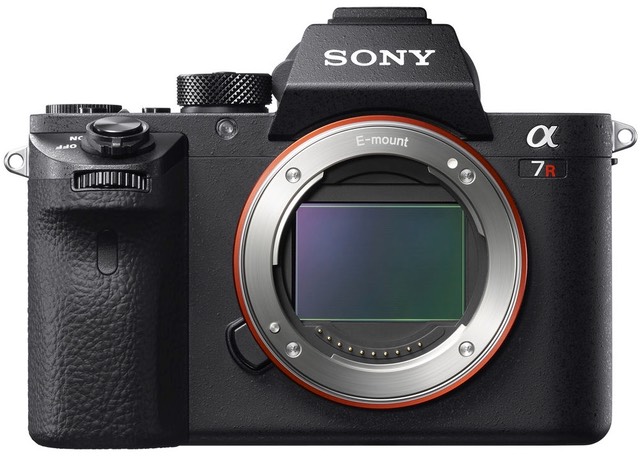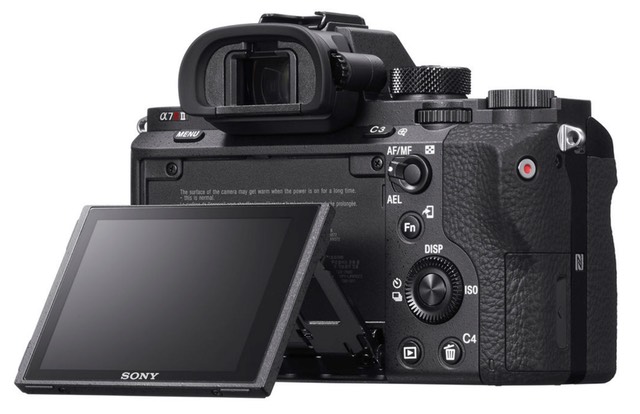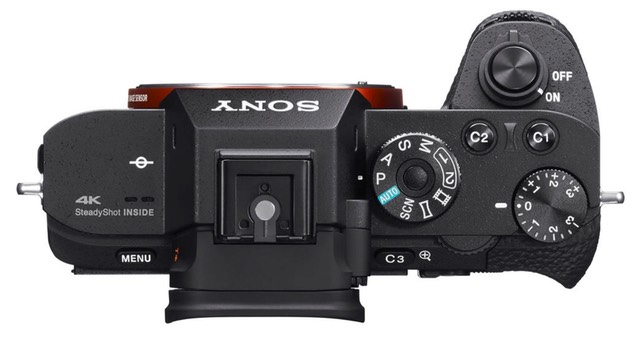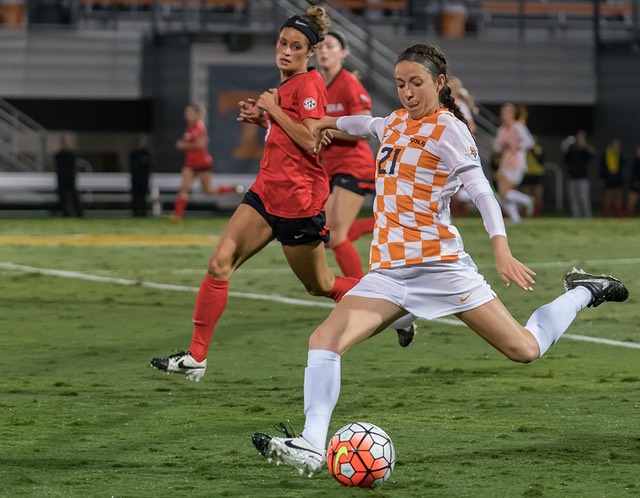
What is It?
While some of the various A7 Mark II models got slightly fewer changes, the A7rII is a decidedly different beast than the model it replaces. Let’s get right to the key changes:
- 42mp BSI sensor (previously 36mp conventional)
- 399 point phase detect autofocus system on the sensor (previously contrast detect)
- 5 axis sensor-based IS (previously only lens IS supported)
- Electronic front curtain shutter (previously all mechanical)
- 5 fps continuous frame rate (previously 1.5 fps)
- 4K video (previously 1080P only)
- XAVC S 50Mbps video encoding (60/100 for 4k)(previously AVCHD 28Mbps)
- S-Log2 support (previously missing)
- Uncompressed raw via firmware update (previously only compressed raw)
- Redesigned body with better grip and hand position (previously camera was smaller)
Unfortunately, the price for all this went up US$900 to US$3199. (Current price is US$2900, and there are often short-term discounts available.)
The 42mp A7rII is at the top of Sony’s A7 lineup, as is the 12mp A7sII, which emphasizes low light ability compared to the A7rII’s more pixels emphasis. If you're looking for a more generalized camera, the 24mp A7 II is the correct choice.
The A7rII is a full frame sensor (FE mount lenses required) mirrorless camera that lines up fairly well in terms of features and specifications to the Nikon D810. To many, it’s the reason to move from DSLR to mirrorless.
Wait, what? It seems that the so-called compelling things about moving from a DSLR such as the D810 to the A7rII mostly derive around size/weight. What is that difference, exactly? 22 ounces (625g) for the Sony versus 34 ounces (980g) for the Nikon. In terms of overall volume, the Sony occupies about half the space in a camera bag that the D810 does. That last bit is somewhat deceptive, as the the D810 has a deep hand grip and a more prominent prism hump; it’s not exactly that the Sony is 50% the volume of a D810 while being equal in all things.
Another aspect that tended to weight people’s impressions toward the Sony A7rII over the D810 was “lens size.” But comparing f/4 zooms against f/2.8 zooms isn’t exactly an apples-to-apples comparison, and as Sony began launching f/2.8 FE zooms it became apparent that there is no size advantage at f/2.8, at least for the 24-70mm and 70-200mm versions. This is important, because those lenses start to minimize the size/weight advantage of the A7rII, and it may very well be less than you think when you do a very direct comparison.
That said, one of the things I’ve appreciated about the A7rII is that you can indeed pack a small, competent lens set compared to the DSLRs. Thus, something like the A7rII with the Loxia 21mm is an incredibly small package (though note that the D810 with a Voigtlander 20mm is also quite portable, though still bigger and heavier than the A7rII).
Thus, if you’re assessing the Sony because of system size, be very careful that you’re making similar lens choices. Moreover, note that smaller body size has some additional components to it: the size of the buttons and controls on the Sony A7rII are downsized, too. I’ll have more to say about this in the handling section, below, but just remember that there are no free lunches.
Overall, the Sony A7rII is a remarkable technological achievement. There’s hardly a thing that hasn’t been squeezed into this camera. It includes Wi-Fi and just about every other feature you’d expect in a camera of this price, including a 1/8000 mechanical shutter that syncs at 1/250. In terms of continuous shooting speed, it matches the 5 fps of the D810, too.
Indeed, if you line up the feature sets of the A7rII and D810, the primary differences (other than camera style) amount to:
- Favors D810
- More image cropping options on the D810 while shooting
- A lower minimum ISO (32 compared to 50) on the D810
- The D810 can shoot directly in TIFF and has more raw format options
- The D810 has a built-in flash
- The D810 uses USB 3.0, A7rII USB 2.0
- Favors A7rII
- Sensor-based image stabilization on the A7rII
- The A7rII has more phase detect focus points (399 versus 51)
- Sony includes a bunch of Scene Exposure modes
- The A7rII can shoot 4K video (at 30/25/24P)
- The A7rII includes Wi-Fi built in
One key difference that very well might come into play for serious shooters is battery life. The A7rII nets 290 shots CIPA, the D810 manages 1200.
In short, the A7rII absolutely competes with high-end DSLRs in terms of features. In practice, I see very little difference between the 36mp and 42mp pixel sizes that would have you pick one over the other.

How’s it Handle?
A number of reviews have complained about the Sony A7 menus. Typically they talk about disorganization. Sony fans come back with rejoinders that they’re no less disorganized than Nikon and Canon DSLR menus. I think both sides miss the point. The real point is this: Sony uses a fairly structured, organized approach to menus, but there is a ton of cruft in those menus and settings you’d tend to change together can be littered across multiple non-adjacent pages. Cruft is stuff I simply will never set or use. The network and PlayMemories menus, in particular, just tend to be clutter as you try to maneuver among the other menu options. And why is Airplane Mode defaulted to Off?
As I note, associated items are often scattered across multiple pages in the menus, rather than grouped logically. This is the disorganization that many refer to: until you get 100% familiar with where everything is in the menu system, you’re going to be doing a lot of button pressing to find it. But I would add: even if you know where something is, you end up doing a lot of button pressing to find a setting.
Personally, I don’t find this a big issue, but it has proven to be an issue at times while shooting: the disorganization means you make settings changes more slowly (yes, I’m aware of the Fn shortcut for quick setting a few critical items; that helps, but isn’t a complete answer).
One of the biggest issues I have with the A7rII in handling has to do with card writes. If the camera is writing to the card after you’ve let go of the shutter release, you can’t really do anything in the playback, menu, and control systems until the buffer flushes.
This can be very annoying if you’re using the camera in continuous sequences, for example the sports work I’ve done with the A7rII. When I’ve got back button focus enabled (AF-On), I run into this delay all the time. You can’t focus again until the buffer flushes, even though you might not be trying to take another shot yet (“Writing to memory card. Unable to operate”). This is annoying and wrong. Indeed, it tends to make the camera more of a one-shot-at-a-time tool, which at this price level is unexpected. (I note that Sony fixed this in the A9.)
Meanwhile, Sony still seems hung up on the way they’ve set up PlayMemories, and it’s now something I’d call somewhat sub-optimal in a camera of this level. Plus some of the messages the camera provides are annoyingly Japlish (“Information of the computer where the data is to be saved is not set to the device” instead of “Camera is not connected to a computer”).
But probably the biggest issue with the A7rII has to do with its size: smaller body size means smaller button/control size. It doesn’t help that many of the buttons are also somewhat recessed. Even without gloves I sometimes have trouble finding a button like C3 and especially C4 by feel. With gloves? Pretty much all the controls are tough to use, and not always in the place where they’d be most useful.

The good news is that the locking Mode dial and the stiff Exposure Compensation dial don’t net you the random settings problem I’ve found with many other small camera implementations.
Overall, the largest weakness of the A7rII is the handling. Many of the buttons/controls are not sized/placed right for shooting-by-feel. The MENU button feels odd all by itself on the top left, especially since it’s used as the “back” button in the menu system you’re navigating with the Direction pad on the other side of the camera. The menus could use a professional reorganization. The buffer impinges on continuous shooting use.
The eventual A7r Mark III upgrade really needs to address the handling issues of this camera. That would bring the camera up to a level that is clearly in DSLR territory. As it stands, the A7rII just misses, and all because of sub-optimal handling issues at this price level.
How’s it Perform?
Video: One thing that needs to be pointed out is that when you shoot 4K video—actually UHD video—you’re shooting with a near APS-sized portion of the sensor. In other words, 4K video is a crop and changes your focal length choices. That said, shooting XAVC S at 30 fps and 100Mbps produces very nice, high quality video. One slight drawback is that you need a U3 class card to record this footage. Another drawback is that I see more moire and low level artifacts in the A7rII 4K video than I do with the Panasonic GH4. Edges look crisper on the Sony than the Panasonic, but those artifacts can and do cause visible issues on panning and motion. You might not see this if you’re not viewing on a true 4K screen, by the way.
Focus: As you'll see a bit further on, one of the many tests I've done with the A7rII over the course of my ownership is to use it for sports. No, it doesn't match my D5. Yes, it's usable.
Let's start with single focus (AF-S): I have no issues at all with this mode. It's fast, it's highly dependable, and things like face detect can make it uncanny at times.
With continuous focus (e.g. the sports shooting I've been doing with this camera) things change. Generally, the first shot in a sequence is fine, particularly when you've enabled Pre-AF. It's when the motion is continuous, fast, and erratic that the A7rII starts to stumble a bit. I've seen other folk claim that their big buffer sequences from the A7rII are "in focus." Or in dpreview's case, occasionally "noticeably less than perfect." Go to that page I linked to and look particularly at images 12 through 15 in the first tracking test. I see a lot of that in my sports footage with the A7rII: the focus plane drifts in and out of where it should be in continuous sequences. I don't see that with my D5 (or D500, or really any other Nikon DSLR that I use).
I believe this has to do with the way Sony is managing focus behind the scenes. Phase detect on sensor has a geometric deficit compared to the DSLR phase detect systems, so most mirrorless cameras follow a phase detect move with a contrast detect move to obtain better focus precision. Unfortunately, when you're running the camera continuously, you can't let the contrast detect system keep cycling to try and find the perfect focus plane, otherwise you could get an open loop situation. Thus, the A7rII is "punting" every now and again on focus.
This can be a little disappointing at times. You'll get the shot you wanted in one sequence, but find another sequence where the moment in time you want has gone soft (didn't focus precisely). Whether you can tolerate this drifting focus problem or not is dependent upon your tolerance level. For me, the A7rII is manageable, but barely.
Indeed, I'll look for sequences where I'm more parallel to the action than having it come straight at me (or away from me) because of this issue. The likelihood of a parallel action being wholly in focus in every frame is far higher than when the action is moving at you.
Dynamic Range: the obvious comparison is to the Nikon D810. Pushing the shadows in uncompressed raw images taken at low ISO with both cameras produces very similar results, with the D810 having slightly less noise in the deepest shadows. If you use the A7rII in all electronic shutter mode continuously, the D810 clearly pulls ahead in terms of noise propagation in the shadows.
It seems clear on looking at low level data that Sony took a slightly different approach on the A7rII sensor than Nikon did with the D810. The D810 is nearly ISO-less, and peaks at about 11.5 stops of DR at ISO 100. From there, the dynamic range falls in a line as you boost ISO.
For the Sony, there appears to be a clear gain change at ISO 400 and again at ISO 20,000. But more interestingly, the dynamic range below ISO 400 seems to be limited by the sensor electronics. Thus, at ISO 100, the Sony maxes out at about 10 stops of DR.
Still, we’re talking about near state-of-the-art here, and we’re splitting nits to declare a winner. D810 users who are jealous of the A7rII need not be jealous of the low level data quality: the D810 clearly holds its own and I prefer the D810 14-bit raws over the Sony 14-bit raws because there’s just a slight bit more integrity if you’re going to be extremely aggressive about pushing up shadows. That said, I have absolutely no issues with the A7rII’s raws now that we have the uncompressed option (other than perhaps file size and buffer performance). Sony and Nikon are clearly out in front of the others in providing deep, clean dynamic range right now.
What's it look like at ISO 6400? Try this:

And since that's obviously downsized, let's look at actual pixels:

I've used ACR's noise reduction a bit on this image, but you can see that I'm still getting a fair amount of hair detail while the noise is negligible. After looking at this, I'd probably opt to allow a bit more noise through to get a slightly better acuity on detail if I post processed this again. But the net result is still the same: I'm comfortable shooting this camera out to ISO 6400, for sure. Maybe higher.
Resolution: 42mp isn’t enough change from 36mp to actually produce visible resolution gains. We get 492 more pixels across the long axis, a net gain of less than 7%. That simply isn’t visible in prints, even up to 24” across. Where it might be useful—and to some degree I found that shooting sports with the A7rII—is that you get a little more cropping ability without dropping the pixel count low.
Low Light: Some users are surprised that large pixel counts don’t seem to make low lighting shooting a problem. Ten years ago that was definitely true, but sensor technologies have now gotten to a level where a number of issues we were fighting back then (read noise, fixed pattern noise, low fill levels, low efficiency, etc.) are no longer the gating issue.
For virtually all current cameras it’s usually quantum shot noise that is the gating element to low light work now. Thus, the biggest thing you can change is how much area you’re capturing. Thus, full frame is preferred to APS crop, which is in turn preferred to m4/3 crop.
If you don’t crop—that’s a big if for some of you—the A7rII does quite well in low light. I’m not afraid to use it at ISO 3200, and I’ve even pushed it in some situations to ISO 6400 (see above) without concern. Of course, if you start cropping significantly or you pixel peep, you’re going to see noise.
Meanwhile, the Sony JPEG engine seems to have been tweaked on the A7rII over previous models, and I’d tend to say that it delivers very nice looking JPEGs. The old over-noise-reduced-and-sharpened tendency seems to have been directly addressed. If anything, Sony is now backed off a little more on noise reduction in JPEGs than they could get away with (especially on a 42mp camera).
Final Words
No doubt about it, Sony has created a beast with the refresh of the A7r into Mark II form. While the original version had a number of very serious warts that caused it to be not quite what we expected, the A7rII has fixed most of the big things, added lots of useful new things, improved performance in almost every category, and the entire camera just feels better in the hand while shooting.
Coupled with the many fine lenses that are starting to appear—notably the Zeiss and GM optics—the FE mount is becoming a serious contender for serious shooters. The A7rII is the camera that makes those lenses shine the most.
There are still some small(er) warts that might keep you from completely enjoying the camera. For me, the way the AF is controlled is a big one. The focus system is good enough that it deserves better than the old point and shoot style focus options. And back button focus being locked while the camera clears the buffer just clobbers some uses of the camera.
On a similar subject, button size, position, and feel still aren't perfectly ergonomic, though they're better than on the previous model. Sony needs to really address the usability issues on this camera to create a head-turning winner.
The EVF/LCD switchover is a little too frisky for my taste, and our options for dealing with that not great. The menu system is disorganized and sprawling, though mostly understandable. The card write speed could use improvement, as the buffer clears slowly. Continuous autofocus has a number of modest drawbacks to it, though the camera can track decently enough to be considered for some light sports work.
But probably the thing that is highest on the drawback list is battery life. The A7rII can truly eat batteries if you press it. This is a camera that really required a much bigger battery. The good news, of course, is that you can simply buy a handful and carry them with you at all times—they’re not that big and heavy—but that still doesn’t keep you from being in the heat of a shooting session and suddenly discovering your camera stopped working and you missed a key shot. A key design parameter of such an expensive camera should always be “never miss a shot.” I can’t quite say that about the A7rII.
On the other hand, if you’re a methodical shooter (e.g. landscape photographer), many of the things that I would list as drawbacks on the A7rII simply aren’t, though the D810 shooter is going to beat you in deep shadows at base ISO. If you’re a more casual shooter, none of the things I’ve outlined above are going to be of large concern to you.
So I’d have to say that whether you’ll truly love the A7rII or not is a lot about your photographic situation and style. Sports photography. No, that’s at the extreme where the little things still not right about the A7rII will likely get in your way. Casual travel photography. Yes, none of the things I’ve pointed out are likely to be very relevant to you and the camera’s not going to get in your way (though carry extra batteries). The continuum in between those two extremes is where we have more problems deciding upon whether the A7rII works for you or not.
The A7rII excels on image quality, proliferation of features, even video capability. It handles low light decently. It focuses well for all but the fastest-moving subjects. Sony’s even managed to make their JPEGs look better than previously, without quite as much of the NR mush as they used to invoke. The sensor IS is very nice to have.
I’ll go out on the limb and say this: if your shooting is more about slower moving or still subjects, the A7rII is going to be a great camera for you. If your subject is moving fast and erratically, then not so much.
I’ve now shot with an A7rII on assignments throughout the world for almost two years. What I can say is this: the image quality is excellent, and that will likely never be an issue for you. Handling will be the reason you decide you can live with the A7rII or decide to skip it. So if you have any doubt, borrow one and shoot with it a bit before committing the big bucks to this body (and to a new set of lenses).
I’ve learned to live with the A7rII. For some assignments, it’s my first choice because it, coupled with a set of the f/4 zooms, that makes for a small, light, and highly competent system. Ditto with a choice selection of primes. For general travel and landscape photography, the A7rII tends to be my first choice these days because of the balance of size/weight and competence. For everything else I do (wildlife, sports, some events), not so much.
Your mileage may vary. But I’m serious: the thing that will make or break the A7rII for you is how it handles during shooting. How fast you can control settings, how fast you can find things in the menu, how that buffer interacts with what you’re trying to do. Yes, I know the camera has configurable buttons, and that certainly helps with the first two items, but that last item isn’t user modifiable in any way.
Recommended (2016, 2017, 2018) consider either the later models instead.